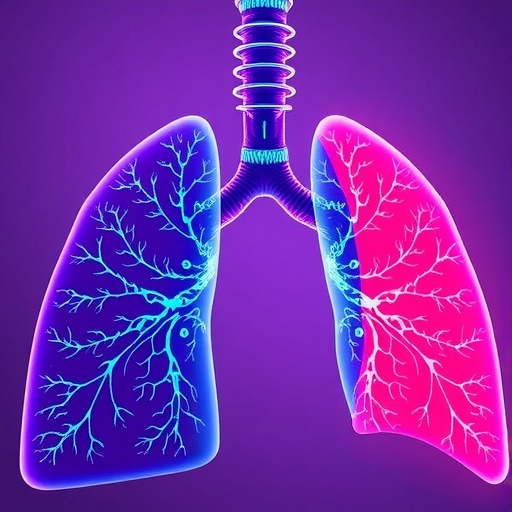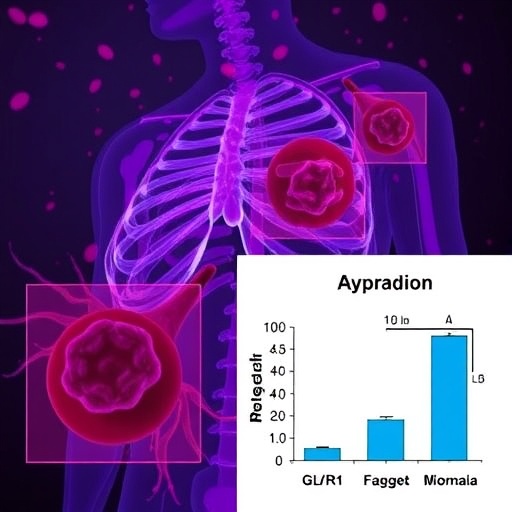In recent years, the treatment paradigm for non-small-cell lung cancer (NSCLC) has undergone a transformative shift, primarily driven by the advent and integration of immune-checkpoint inhibitors (ICIs) into first-line therapeutic regimens. These groundbreaking agents, which unleash the patient’s own immune system to recognize and attack tumor cells, have redefined clinical outcomes for many individuals living with advanced NSCLC. Despite these advances, the clinical reality remains sobering: the vast majority of patients either exhibit primary resistance to ICIs from the outset or acquire secondary resistance after initial responses. This resistance phenomenon poses a substantial obstacle to durable disease control and long-term survival.
The biological underpinnings of ICI resistance are layered and complex, involving both intrinsic tumor factors and adaptive alterations within the tumor microenvironment (TME). Tumor cells can escape immune destruction through a panoply of mechanisms, ranging from genetic and epigenetic modifications that alter antigen presentation and immune recognition to the evolution of immunosuppressive stromal components that blunt effective immune cell infiltration and effector function. Additionally, host-related influences, including dysbiosis of the gut microbiome and organ-specific pathologies, further modulate the landscape of resistance, highlighting the multifactorial nature of immune escape in NSCLC.
Crucially, while the molecular and cellular routes to resistance are diverse, they often converge on a shared endpoint: the establishment of an immunosuppressive TME. This hostile milieu orchestrates a blockade of antitumor immunity, rendering ICIs ineffective despite their initial promise. Thus, current research and therapeutic strategies have increasingly focused on disrupting or reprogramming the immunosuppressive circuitry within the TME to restore effective immune surveillance and cytotoxicity.
.adsslot_NYlstRk9m8{ width:728px !important; height:90px !important; }
@media (max-width:1199px) { .adsslot_NYlstRk9m8{ width:468px !important; height:60px !important; } }
@media (max-width:767px) { .adsslot_NYlstRk9m8{ width:320px !important; height:50px !important; } }
ADVERTISEMENT
Emerging antibody-based modalities constitute a major pillar of these efforts. Innovative constructs such as bispecific antibodies, T cell engagers, and antibody-drug conjugates are designed to simultaneously target multiple immunoregulatory pathways or deliver cytotoxic payloads selectively to malignant cells. These multifunctional biologics aim to circumvent resistance mechanisms by either reinvigorating exhausted T cells or directly eliminating suppressive cell populations within the tumor niche.
Beyond antibodies, small molecule targeted therapies offer additional avenues to counteract resistance. By inhibiting tumor-intrinsic signaling pathways that promote immune evasion or by reshaping the TME through modulation of stromal or myeloid cell functions, these agents may re-sensitize tumors to immune checkpoint blockade. Moreover, combination regimens that integrate targeted inhibitors with ICIs are under active clinical investigation, seeking synergistic effects against refractory NSCLC.
Adoptive cell therapies also hold promise as next-generation immune interventions. Techniques such as chimeric antigen receptor (CAR) T-cell therapy and tumor-infiltrating lymphocyte (TIL) expansion are being refined to enhance specificity, persistence, and tumor homing in solid tumors like NSCLC. These personalized immunotherapies may overcome some intrinsic barriers posed by the tumor and its microenvironment, offering potential salvage options for patients with checkpoint-resistant disease.
Therapeutic cancer vaccines and intratumoral immunotherapies represent additional innovative frontiers. These strategies aim to boost tumor antigen presentation and prime endogenous immune responses directly within the tumor milieu. By localizing immune activation and circumventing systemic immune suppression, they may create focal points of antitumor immunity conducive to durable disease control.
Despite the proliferation of novel therapeutic approaches, the identification and validation of robust predictive biomarkers for immune resistance remain a critical unmet need. Current biomarkers, often derived from sequencing or immunohistochemical analyses, provide incomplete prognostication, reflecting the heterogeneity and dynamic nature of resistance mechanisms. The complexity is compounded by the spatial and temporal variability in tumor and immune cell phenotypes, necessitating longitudinal and multifaceted biomarker strategies.
To effectively navigate this complexity, adaptive, hypothesis-generating clinical trial designs have garnered attention. Such flexible frameworks enable real-time integration of biomarker data and allow brisk incorporation of emerging therapeutic concepts. This iterative approach may accelerate the discovery of effective combination regimens and personalized treatment strategies tailored to the evolving resistance profiles of individual patients.
In parallel, advances in spatial transcriptomics, multiplex immunofluorescence, and single-cell sequencing technologies are shedding light on the intricate cellular interplay within the NSCLC microenvironment. These tools facilitate high-resolution mapping of immune and stromal components, revealing potential vulnerabilities and resistance drivers that may be therapeutically exploitable. Integrating these molecular insights into clinical practice remains a critical translational challenge.
Furthermore, the role of the gut microbiome in shaping systemic immunity and modulating responses to ICIs has emerged as a fascinating area of study. Dysbiosis—disruption of the normally balanced microbial communities—can negatively impact immune competence and foster resistance. Therapeutic manipulation of the microbiome through probiotics, antibiotics, or fecal microbiota transplantation is under exploration as an adjunct to immunotherapy.
Organ-specific microenvironments, such as those in the brain or liver where metastatic lesions commonly reside, also impose unique immunological constraints. Understanding how these sites influence immune cell trafficking and function will be pivotal in designing therapies that overcome tissue-specific barriers to checkpoint inhibitor efficacy.
Taken together, these insights underscore a paradigm shift in NSCLC treatment from monolithic checkpoint blockade to sophisticated, multi-modal strategies tailored to dismantle the immunosuppressive fortress encasing resistant tumors. Interdisciplinary collaboration among oncologists, immunologists, molecular biologists, and bioinformaticians is crucial in accelerating this progress.
While substantial challenges persist, the trajectory of research efforts offers a cautiously optimistic outlook. Early-phase clinical trials of combination regimens and novel immune-activating platforms have reported encouraging signals of efficacy. Continued refinement of therapeutic approaches and biomarker-guided patient selection promise to enhance response rates and extend survival benefits beyond what was once achievable.
As the field moves forward, a comprehensive understanding of the dynamic interplay between tumor biology, the immune milieu, and host factors will be essential. This holistic perspective will enable the design of rational interventions to preempt, delay, or reverse resistance to ICIs in NSCLC, transforming a currently intractable problem into a manageable clinical reality.
In summary, the battle against immune checkpoint inhibitor resistance in NSCLC is entering a new chapter defined by scientific ingenuity and clinical innovation. By harnessing emerging technologies, embracing adaptive trial designs, and integrating multidimensional biomarkers, researchers are steadily unraveling the complexities that have long thwarted durable immunotherapeutic success. The coming years may well witness the translation of these advances into tangible improvements in patient care worldwide.
Subject of Research: Resistance to immune-checkpoint inhibitors in advanced non-small-cell lung cancer and emerging therapeutic strategies.
Article Title: Treatment of NSCLC after chemoimmunotherapy — are we making headway?
Article References: Reck, M., Frost, N., Peters, S. et al. Treatment of NSCLC after chemoimmunotherapy — are we making headway?. Nat Rev Clin Oncol (2025). https://doi.org/10.1038/s41571-025-01061-7
Image Credits: AI Generated
DOI: 10.1038/s41571-025-01061-7
Keywords: non-small-cell lung cancer, immune-checkpoint inhibitors, immune resistance, tumor microenvironment, bispecific antibodies, T cell engagers, adoptive cell therapy, therapeutic vaccines, biomarker-driven studies
Tags: biological factors influencing NSCLC resistancedurable disease control in NSCLCgut microbiome and cancer therapyimmune checkpoint inhibitors in lung cancerimmunotherapy and long-term survival in NSCLCNSCLC treatment advancementsovercoming resistance in lung cancer treatmentprimary resistance to cancer immunotherapyresistance mechanisms in non-small-cell lung cancersecondary resistance in NSCLC therapytherapeutic strategies for advanced lung cancertumor microenvironment and immune response





